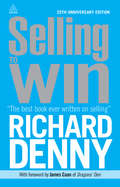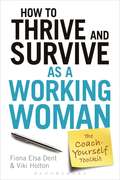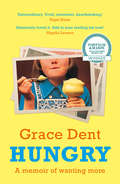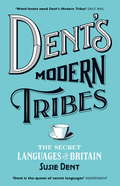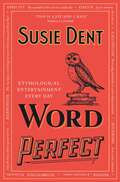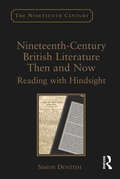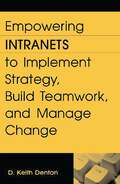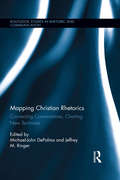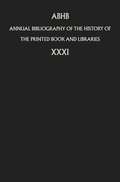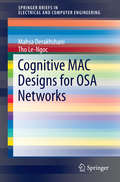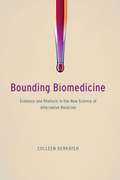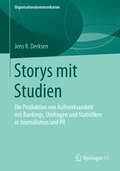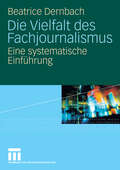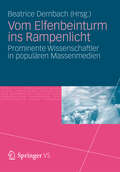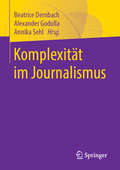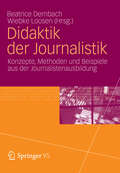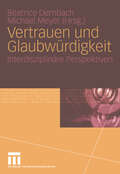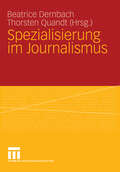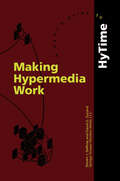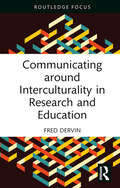- Table View
- List View
Selling to Win: Tested Techniques For Closing The Sale (Marketing And Sales Ser.)
by Richard DennyRecognized internationally as one of the most effective sales improvement guides ever written, Selling to Win is an invaluable text for sales and marketing professionals. It explains clearly how to put winning techniques into action, featuring advice on getting a sale despite not being the cheapest, turning a customer into an ambassador, building a positive attitude that gets results, beating the competition and closing a sale. This 25th anniversary edition of Selling to Win has been revised and is full of even more sales tips and essential practical advice. With a foreword from James Caan, successful entrepreneur, author and former investor on BBC's Dragon's Den, it has been updated to reflect current selling techniques and includes success stories from readers of the previous editions who applied what they learned in the book.
How to Thrive and Survive as a Working Woman: The Coach-Yourself Toolkit
by Fiona Elsa Dent Viki HoltonHave you read all the books out there on getting to the top but find yourself wanting not necessarily tips for achieving a high-flying career, but the tools for creating a fulfilling working life?Based on new data from surveys and interviews, How to Thrive and Survive as a Working Woman will encompass stories, examples, strategies and practical exercises. The content will be both instructive and interactive offering insights from the authors' own experience of working with many women managers who attend Ashridge Business School programmes and events. The book will focus on key issues for development and career success and apply these to the specific challenges facing women at work, including: getting started in your career; dealing with motherhood and a career; dual career couples; changing career direction; moving up to senior levels; lack of confidence; and developing a clear career plan. Offering tips, techniques and approaches, this book will be an essential tool for working women of all ages and at various stages in their career.
Hungry: The Highly Anticipated Memoir From One Of The Greatest Food Writers Of All Time
by Grace Dent‘Extraordinary. Vivid, irreverent, heartbreaking.’ NIGEL SLATER ‘So funny and so delicious. I could eat it.’ DAWN O’PORTER
Dent's Modern Tribes: The Secret Languages of Britain
by Susie DentDid you know that . . . a soldier's biggest social blunder is called jack brew - making yourself a cuppa without making one for anyone else? That twitchers have an expression for a bird that can't be identified - LBJ (the letters stand for Little Brown Job)? Or that builders call plastering the ceiling doing Lionel Richie's dancefloor? Susie Dent does.Ever wondered why football managers all speak the same way, what a cabbie calls the Houses of Parliament, or how ticket inspectors discreetly request back-up? We are surrounded by hundreds of tribes, each speaking their own distinct slanguage of colourful words, jokes and phrases, honed through years of conversations on the battlefield, in A&E, backstage, or at ten-thousand feet in the air. Susie Dent has spent years interviewing hundreds of professionals, hobbyists and enthusiasts, and the result is an idiosyncratic phrasebook like no other. From the Freemason's handshake to the publican's banter, Dent's Modern Tribes takes us on a whirlwind tour of Britain, decoding its secret languages and, in the process, finds out what really makes us all tick.
Word Perfect: Etymological Entertainment For Every Day of the Year
by Susie Dent'Susie Dent is a one-off. She breathes life and fun into words and language' Pam Ayres'Susie Dent is a national treasure' Richard OsmanWelcome to a year of wonder with Susie Dent, lexicographer, logophile, and longtime queen of Countdown's Dictionary Corner.From the real Jack the Lad to the theatrically literal story behind stealing someone's thunder, from tartle (forgetting someone's name at the very moment you need it) to snaccident (the unintentional eating of an entire packet of biscuits), WORD PERFECT is a brilliant linguistic almanac full of unforgettable stories, fascinating facts, and surprising etymologies tied to every day of the year. You'll never be lost for words again.
Nineteenth-Century British Literature Then and Now: Reading with Hindsight (The Nineteenth Century Series)
by Simon DentithEnvisioning today’s readers as poised between an impossible attempt to read texts as their original readers experienced them and an awareness of our own temporal moment, Simon Dentith complicates traditional prejudices against hindsight to approach issues of interpretation and historicity in nineteenth-century literature. Suggesting that the characteristic aesthetic attitude encouraged by the backward look is one of irony rather than remorse or regret, he examines works by Charles Dickens, George Eliot, Anthony Trollope, William Morris and John Ruskin in terms of their participation in significant histories that extend to this day. Liberalism, class, gender, political representation and notions of progress, utopianism and ecological concern as currently understood can be traced back to the nineteenth century. Just as today’s critics strive to respect the authenticity of nineteenth-century writers and readers who responded to these ideas within their historical world, so, too, do those nineteenth-century imaginings persist to challenge the assumptions of the present. It is therefore possible, Dentith argues, to conceive of the act of reading historical literature with an awareness of the historical context and of the difference between the past and the present while allowing that friction or difference to be part of how we think about a text and how it communicates. His book summons us to consider how words travel to the reality of the reader’s own time and how engagement with nineteenth-century writers’ anticipation of the judgements of future generations reveal hindsight’s capacity to transform our understanding of the past in the light of subsequent knowledge.
Nineteenth-Century British Literature Then and Now: Reading with Hindsight (The Nineteenth Century Series)
by Simon DentithEnvisioning today’s readers as poised between an impossible attempt to read texts as their original readers experienced them and an awareness of our own temporal moment, Simon Dentith complicates traditional prejudices against hindsight to approach issues of interpretation and historicity in nineteenth-century literature. Suggesting that the characteristic aesthetic attitude encouraged by the backward look is one of irony rather than remorse or regret, he examines works by Charles Dickens, George Eliot, Anthony Trollope, William Morris and John Ruskin in terms of their participation in significant histories that extend to this day. Liberalism, class, gender, political representation and notions of progress, utopianism and ecological concern as currently understood can be traced back to the nineteenth century. Just as today’s critics strive to respect the authenticity of nineteenth-century writers and readers who responded to these ideas within their historical world, so, too, do those nineteenth-century imaginings persist to challenge the assumptions of the present. It is therefore possible, Dentith argues, to conceive of the act of reading historical literature with an awareness of the historical context and of the difference between the past and the present while allowing that friction or difference to be part of how we think about a text and how it communicates. His book summons us to consider how words travel to the reality of the reader’s own time and how engagement with nineteenth-century writers’ anticipation of the judgements of future generations reveal hindsight’s capacity to transform our understanding of the past in the light of subsequent knowledge.
Empowering Intranets to Implement Strategy, Build Teamwork, and Manage Change
by D. Keith DentonTechnologically driven information overloads corporate leaders, managers, and employees alike, forcing them into a reactive mode with little time for reflection or strategic thinking. When the survey is completed, the teleconference over, and the weekend retreat a distant memory, we go back to our jobs unchanged. We hope that our activities contribute to corporate objectives, but we quickly lose sight of the connection between our work and critical outcomes. It doesn't have to be that way. Denton explains how to combine new interactive Intranet Web-based technology with new managerial software to focus on strategic decision making, effective team management, and the big picture.Along with its companion Web site, www.CIVID3.com, this book provides an innovative solution that integrates and displays your critical information in real time. Condense all the reports received from finance, operations, marketing, and other divisions into a single interactive visual display that's always up to date. Establish two-way communication that allows managers and workers at all levels of the company to participate. This is the first system to graphically display—on a single desktop screen—the status of your key organizational and group performance measures. Combine outcomes and processes. Use subjective as well as objective information. Integrate and display the results in a user-friendly format, in real time. This book's solution allows organizational members to focus on their ultimate purpose and makes it easier to implement strategic or operational decisions.
Mapping Christian Rhetorics: Connecting Conversations, Charting New Territories (Routledge Studies in Rhetoric and Communication)
by Michael-John DePalma Jeffrey M. RingerThe continued importance of Christian rhetorics in political, social, pedagogical, and civic affairs suggests that such rhetorics not only belong on the map of rhetorical studies, but are indeed essential to the geography of rhetorical studies in the twenty-first century. This collection argues that concerning ourselves with religious rhetorics in general and Christian rhetorics in particular tells us something about rhetoric itself—its boundaries, its characteristics, its functionings. In assembling original research on the intersections of rhetoric and Christianity from prominent and emerging scholars, Mapping Christian Rhetorics seeks to locate religion more centrally within the geography of rhetorical studies in the twenty-first century. It does so by acknowledging work on Christian rhetorics that has been overlooked or ignored; connecting domains of knowledge and research areas pertaining to Christian rhetorics that may remain disconnected or under connected; and charting new avenues of inquiry about Christian rhetorics that might invigorate theory-building, teaching, research, and civic engagement. In dividing the terrain of Christian rhetorics into four categories—theory, education, methodology, and civic engagement—Mapping Christian Rhetorics aims to foster connections among these areas of inquiry and spur future future collaboration between scholars of religious rhetoric in a range of research areas.
Mapping Christian Rhetorics: Connecting Conversations, Charting New Territories (Routledge Studies in Rhetoric and Communication)
by Michael-John DePalma Jeffrey M. RingerThe continued importance of Christian rhetorics in political, social, pedagogical, and civic affairs suggests that such rhetorics not only belong on the map of rhetorical studies, but are indeed essential to the geography of rhetorical studies in the twenty-first century. This collection argues that concerning ourselves with religious rhetorics in general and Christian rhetorics in particular tells us something about rhetoric itself—its boundaries, its characteristics, its functionings. In assembling original research on the intersections of rhetoric and Christianity from prominent and emerging scholars, Mapping Christian Rhetorics seeks to locate religion more centrally within the geography of rhetorical studies in the twenty-first century. It does so by acknowledging work on Christian rhetorics that has been overlooked or ignored; connecting domains of knowledge and research areas pertaining to Christian rhetorics that may remain disconnected or under connected; and charting new avenues of inquiry about Christian rhetorics that might invigorate theory-building, teaching, research, and civic engagement. In dividing the terrain of Christian rhetorics into four categories—theory, education, methodology, and civic engagement—Mapping Christian Rhetorics aims to foster connections among these areas of inquiry and spur future future collaboration between scholars of religious rhetoric in a range of research areas.
Annual Bibliography of the History of the Printed Book and Libraries: Volume 31 (Annual Bibliography of the History of the Printed Book and Libraries #31)
by Department of Information and Collections StaffThe Annual Bibliography of the History of the Printed Book and Libraries aims at recording articles of scholarly value which relate to the history of the printed book, to the history of arts, crafts, techniques and equipment, and of the economic social and cultural environment, involved in its production, distribution, conservation and description.
Cognitive MAC Designs for OSA Networks (SpringerBriefs in Electrical and Computer Engineering)
by Mahsa Derakhshani Tho Le-NgocThis SpringerBrief presents recent advances in the cognitive MAC designs for opportunistic spectrum access (OSA) networks. It covers the basic MAC functionalities and MAC enhancements of IEEE 802.11. Later chapters discuss the existing MAC protocols for OSA and classify them based on characteristic features.The authors provide new research in adaptive carrier sensing-based MAC designs tailored for OSA, which optimize spectrum utilization and ensure a peaceful coexistence of licensed and unlicensed systems. Analytically devised via optimization and game-theoretic approaches, these adaptive MAC designs are shown to effectively reduce collisions between both primary and secondary network users.Researchers and professionals working in wireless communications and networks will find this content valuable. This brief is also a useful study guide for advanced-level students in computer science and electrical engineering.
Bounding Biomedicine: Evidence and Rhetoric in the New Science of Alternative Medicine
by Colleen DerkatchDuring the 1990s, an unprecedented number of Americans turned to complementary and alternative medicine (CAM), an umbrella term encompassing chiropractic, energy healing, herbal medicine, homeopathy, meditation, naturopathy, and traditional Chinese medicine. By 1997, nearly half the US population was seeking CAM, spending at least $27 billion out of pocket. Bounding Biomedicine centers on this boundary-changing era, looking at how consumer demand shook the health care hierarchy. Drawing on scholarship in rhetoric and science and technology studies, the book examines how the medical profession scrambled to maintain its position of privilege and prestige, even as its foothold appeared to be crumbling. Colleen Derkatch analyzes CAM-themed medical journals and related discourse to illustrate how members of the medical establishment applied Western standards of evaluation and peer review to test health practices that did not fit easily (or at all) within standard frameworks of medical research. And she shows that, despite many practitioners’ efforts to eliminate the boundaries between “regular” and “alternative,” this research on CAM and the forms of communication that surrounded it ultimately ended up creating an even greater division between what counts as safe, effective health care and what does not. At a time when debates over treatment choices have flared up again, Bounding Biomedicine gives us a possible blueprint for understanding how the medical establishment will react to this new era of therapeutic change.
Bounding Biomedicine: Evidence and Rhetoric in the New Science of Alternative Medicine
by Colleen DerkatchDuring the 1990s, an unprecedented number of Americans turned to complementary and alternative medicine (CAM), an umbrella term encompassing chiropractic, energy healing, herbal medicine, homeopathy, meditation, naturopathy, and traditional Chinese medicine. By 1997, nearly half the US population was seeking CAM, spending at least $27 billion out of pocket. Bounding Biomedicine centers on this boundary-changing era, looking at how consumer demand shook the health care hierarchy. Drawing on scholarship in rhetoric and science and technology studies, the book examines how the medical profession scrambled to maintain its position of privilege and prestige, even as its foothold appeared to be crumbling. Colleen Derkatch analyzes CAM-themed medical journals and related discourse to illustrate how members of the medical establishment applied Western standards of evaluation and peer review to test health practices that did not fit easily (or at all) within standard frameworks of medical research. And she shows that, despite many practitioners’ efforts to eliminate the boundaries between “regular” and “alternative,” this research on CAM and the forms of communication that surrounded it ultimately ended up creating an even greater division between what counts as safe, effective health care and what does not. At a time when debates over treatment choices have flared up again, Bounding Biomedicine gives us a possible blueprint for understanding how the medical establishment will react to this new era of therapeutic change.
Bounding Biomedicine: Evidence and Rhetoric in the New Science of Alternative Medicine
by Colleen DerkatchDuring the 1990s, an unprecedented number of Americans turned to complementary and alternative medicine (CAM), an umbrella term encompassing chiropractic, energy healing, herbal medicine, homeopathy, meditation, naturopathy, and traditional Chinese medicine. By 1997, nearly half the US population was seeking CAM, spending at least $27 billion out of pocket. Bounding Biomedicine centers on this boundary-changing era, looking at how consumer demand shook the health care hierarchy. Drawing on scholarship in rhetoric and science and technology studies, the book examines how the medical profession scrambled to maintain its position of privilege and prestige, even as its foothold appeared to be crumbling. Colleen Derkatch analyzes CAM-themed medical journals and related discourse to illustrate how members of the medical establishment applied Western standards of evaluation and peer review to test health practices that did not fit easily (or at all) within standard frameworks of medical research. And she shows that, despite many practitioners’ efforts to eliminate the boundaries between “regular” and “alternative,” this research on CAM and the forms of communication that surrounded it ultimately ended up creating an even greater division between what counts as safe, effective health care and what does not. At a time when debates over treatment choices have flared up again, Bounding Biomedicine gives us a possible blueprint for understanding how the medical establishment will react to this new era of therapeutic change.
Bounding Biomedicine: Evidence and Rhetoric in the New Science of Alternative Medicine
by Colleen DerkatchDuring the 1990s, an unprecedented number of Americans turned to complementary and alternative medicine (CAM), an umbrella term encompassing chiropractic, energy healing, herbal medicine, homeopathy, meditation, naturopathy, and traditional Chinese medicine. By 1997, nearly half the US population was seeking CAM, spending at least $27 billion out of pocket. Bounding Biomedicine centers on this boundary-changing era, looking at how consumer demand shook the health care hierarchy. Drawing on scholarship in rhetoric and science and technology studies, the book examines how the medical profession scrambled to maintain its position of privilege and prestige, even as its foothold appeared to be crumbling. Colleen Derkatch analyzes CAM-themed medical journals and related discourse to illustrate how members of the medical establishment applied Western standards of evaluation and peer review to test health practices that did not fit easily (or at all) within standard frameworks of medical research. And she shows that, despite many practitioners’ efforts to eliminate the boundaries between “regular” and “alternative,” this research on CAM and the forms of communication that surrounded it ultimately ended up creating an even greater division between what counts as safe, effective health care and what does not. At a time when debates over treatment choices have flared up again, Bounding Biomedicine gives us a possible blueprint for understanding how the medical establishment will react to this new era of therapeutic change.
Storys mit Studien: Die Produktion von Aufmerksamkeit mit Rankings, Umfragen und Statistiken in Journalismus und PR (Organisationskommunikation)
by Jens R. DerksenMit der Berichterstattung über Studien produzieren PR-Praktiker und Journalisten routiniert öffentliche Aufmerksamkeit, die ihnen und ihren Geld- und Arbeitgebern die Durchsetztung von Interessen ermöglichen sollen. In seiner Dissertation zeigt Jens R. Derksen die Relevanz, die systematisch-empirische Erhebungen – wie wissenschaftliche Untersuchungen, Umfragen, Rankings – für die Berichterstattung von Medien und die PR von Organisationen haben. Der Autor stellt dar, welche Studien es in die Schlagzeilen schaffen und wie Medien sie thematisieren. Er analysiert Interessen von Journalisten, Medienorganisationen, PR-Praktikern und Auftraggebern und rekonstruiert Mechanismen, die dem Zustandekommen von Studien und der Berichterstattung darüber zugrunde liegen.
Die Vielfalt des Fachjournalismus: Eine systematische Einführung
by Beatrice DernbachGibt es den Fachjournalismus? Oder sind es viele Fachjournalismen, vom Reise- über den Motor- bis hin zum Medizin- und Wissenschaftsjournalismus? Seit Jahren ist beobachtbar, dass sich Journalismus inhaltlich und thematisch diversifiziert. Er reagiert damit auf den steigenden Bedarf an Spezialwissen in der Life-long-learning-Gesellschaft. Das Buch analysiert diese Entwicklung, indem es zum einen den Themenbereichen selbst und deren Widerspiegelung in der Publizistik nachforscht.
Vom Elfenbeinturm ins Rampenlicht: Prominente Wissenschaftler in populären Massenmedien
by Beatrice DernbachMänner und Frauen aus vielen Disziplinen stehen in meist persönlich geführten, etwa einstündigen Gesprächen Rede und Antwort. Sie reflektieren auch für sich selbst, was sie mit den Medien machen und wie Medien und Journalisten wiederum mit ihnen umgehen. Alle erinnern sich an Ereignisse, die sie in die Medien gebracht haben, was und woraus sie gelernt haben. Sie sprechen über ihre Erfahrungen und geben sie als Empfehlungen an Jüngere weiter.
Komplexität im Journalismus
by Beatrice Dernbach Alexander Godulla Annika SehlDie Beiträge in diesem Band analysieren die komplexen Strukturen im Journalismus und identifizieren einige seiner komplexitätsreduzierenden Strategien. In der modernen Mediengesellschaft kommt Journalismus unter anderem die Aufgabe zu, Transparenz in die gesellschaftlichen Verhältnisse zu bringen. Er erfüllt dies, indem er standardisiert und routiniert Themen selektiert, sie bearbeitet und der öffentlichen Diskussion zur Verfügung stellt. In diesem idealtypischen Verständnis versucht Journalismus, die Vielschichtigkeit und die Vernetzung vieler Ereignisse, Phänomene und sozialer Handlungen zu erklären. Die dafür notwendige Komplexitätsreduktion funktioniert in zwei Richtungen: nach innen und nach außen. Journalismus hat spezifische Strukturen und Routinen entwickelt, um die eigene und die externe Komplexität zu minimieren und damit handlungsfähig zu sein. Der InhaltKomplexitätsforschung ● (Theoretische) Komplexität des Journalismus ● Komplexität journalistischer Binnenstrukturen ● Komplexitätsreduktion in digitalen journalistischen Angeboten ● Journalistische Komplexitätsreduktion in Themenfeldern Die HerausgeberDr. Beatrice Dernbach ist Professorin für „Praktischer Journalismus“ an der Technischen Hochschule Nürnberg und seit den 1990er Jahren in der Journalismusforschung und der akademischen Journalistenausbildung aktiv.Dr. Alexander Godulla ist Professor für Empirische Kommunikations- und Medienforschung am Institut für Kommunikations- und Medienwissenschaft der Universität Leipzig.Dr. Annika Sehl ist Professorin für Digitalen Journalismus am Institut für Journalistik der Universität der Bundeswehr München und Research Associate am Reuters Institute for the Study of Journalism der University of Oxford.
Didaktik der Journalistik: Konzepte, Methoden und Beispiele aus der Journalistenausbildung.
by Beatrice Dernbach Wiebke LoosenSeit vielen Jahren wird darüber diskutiert, dass die journalistische Aus- und Weiterbildung gleichermaßen Theorie und Praxis braucht. In dem Herausgeberband wird vor dem Hintergrund dieser Diskussion gezeigt, mit welchen didaktischen Konzepten sowohl theoretische, methodische und praktische Kenntnisse und Fähigkeiten in unterschiedlichen Ausbildungseinrichtungen (vor allem Hochschulen und Akademien) vermittelt werden. Entstanden ist daraus ein Überblick von Best-Practice-Beispielen aus der Journalistenausbildung, in dem Journalistenausbilderinnen und -ausbilder aus Wissenschaft und Praxis Ideen, Ziele, Vorgehensweisen und Methoden ihrer Lehre vorstellen.
Vertrauen und Glaubwürdigkeit: Interdisziplinäre Perspektiven
by Beatrice Dernbach Michael MeyerVertrauenswürdigkeit von öffentlichen Personen und Institutionen ist für jeden Einzelnen ein wichtiges Kriterium und größtes Problem bei der Meinungsbildung. Eine Diskussion aus der Sicht der Psychologie, der Publizistik, der Politik, der Wirtschaft, der Philosophie, des Rechts und der Kunst kann helfen, aus wechselseitigen Perspektiven neue und übergreifende Einsichten in die Funktion von Vertrauen für die Beziehungen zwischen Personen und Institutionen zu gewinnen.
Spezialisierung im Journalismus
by Beatrice Dernbach Thorsten QuandtAuf die immer stärkere Ausdifferenzierung des Publikums in kleinere und kleinste Interessengruppen reagiert der Journalismus mit einer zunehmenden Spezialisierung: Nahezu jedes vermutete oder offenkundige Publikumsinteresse wird mit publizistischen Angeboten in jeder denkbaren Form bedient. So findet man im Printbereich neben klassischen Allround-Titeln für Wirtschaft, Sport, Politik und Kultur auch Very-special-interest- und Fach-Publikationen für den Geldanleger, den Jazzliebhaber, den Segler, den Angler, den Uhrenfan. Im Internet boomen immer spezialisiertere Webseiten und Blogs. Und auch das Fernsehen entdeckt zunehmend kleinere Nischen und Sparten. Mit den positiven wie negativen Aspekten dieser Spezialisierung setzt sich der vorliegende Sammelband sowohl aus wissenschaftlicher als auch aus praxis-bezogener Sichtweise auseinander.
Making Hypermedia Work: A User’s Guide to HyTime
by S.J. DeRose D. DurandMaking Hypermedia Work: A User's Guide to HyTime discusses how the HyTime standard can be applied to real world problems of navigating from here to there in collections of documents. The HyTime standard itself provides enabling method and templates for various information structures such as links and various kinds of location indicators. A HyTime application specifies how a group applies those templates to their particular requirements. This involves choosing which HyTime structures are needed, setting up conventions for how they are to be used and setting up management and processes for creation, conversion and update of hypermedia documents. A HyTime engine is the last ingredient: actually using an application typically involves choosing software to support one's use of HyTime and customizing it as needed. This may be as simple as setting up hypertextual style sheets that determine how links and other things look and act. More specialized applications may require full-scale design and programming. Making Hypermedia Work: A User's Guide to HyTime presents the first in-depth guide to the HyTime specifications, both describing its key features and providing guidelines on how it is used. The book begins with the more familiar structures of books, graphics and cross-references, detailing the HyTime constructs and models used to identify, locate, and link data. It goes on to introduce some of HyTime's mechanisms for linking multidimensional, multimedia data, and for scheduling it in space and time. The authors help the reader become fluent in HyTime as it applies to the simpler and most widely understood data types. After mastering this level of HyTime, readers will be ready and able to explore the exciting potential of HyTime for more sophisticated multimedia applications.
Communicating around Interculturality in Research and Education (New Perspectives on Teaching Interculturality)
by Fred DervinThis book does not instruct the reader how to communicate interculturally but supports them in reflecting on how they can (re-)negotiate and (re-)construct knowledge(s), ideologies and relations around the notion of interculturality. Anchored in the author’s original and thought-provoking perspectives on interculturality, this interdisciplinary and global-minded book explores how communicating around the notion cannot do away with ideologisms, issues of language and translation or the problematization of voice and silence in research and education. Written in an original and stimulating way, relying on different writing genres and styles to ‘mimic’ the dynamism and flexibility of the very notion under review, the author urges us to (un-)voice, scrutinize, nurture and galvanize our ways of dealing with interculturality alone and together with others in academia. The very specific focus of the book, communicating around interculturality (instead of ‘doing’ interculturality), represents a fresh and important move for observing, analyzing, speaking of and contributing to today's complex and divided world. The title is aimed at researchers, students and educators interested in examining and enriching their own takes on interculturality, from a more reflexive and interactive perspective.
